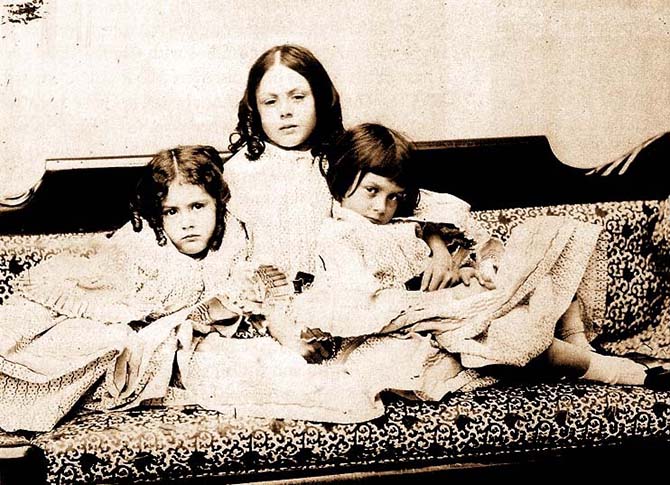
Alice's Adventures Under Ground
Charles Lutwidge Dodgson

The Reverend Charles Lutwidge Dodgson was an accomplished portrait photographer, truly in the vanguard of that art form, given his era --- 1832-1898. He was a gifted and trenchant political satirist, producing numerous pamphlets about politics in Oxford, England, where he lived. He was also a lecturer in mathematics at Oxford's Christ Church College, and authored two 1896 books on logic, Euclid and His Modern Rivals and Symbolic Logic. In addition he produced several volumes of verse and many books of puzzles and games. The Game of Logic (1887) was one. Less than a decade before his death he wrote a children's novel published in two parts, Sylvie and Bruno (1889, 1893).Dodgson enjoyed the company of children, though he didn't have any of his own. He was especially close with the daughters of the Dean of Christ Church College, Lorina, Edith and Alice. One day, as he took the three girls out on the river for a boat trip, he told them a story. He made Alice the star of the tale, which begins with her falling down, down, down an extremely deep hole:
"I wonder if I shall fall right through the earth! How funny it'll seem to come out among the people that walk with their head downwards! The antipathies, I think . . ." (she was rather glad there was no one listening, this time, as it didn't sound at all the right word) " . . . but I shall have to ask them what the name of the country is, you know. Please Ma'am is this New Zealand? Or Australia?" And she tried to curtsey as she spoke --- fancy, curtseying as you're falling through the air! Do you think you could manage it? "And what an ignorant little girl she'll think me for asking! No, it'll never do to ask: Perhaps I shall see it written up somewhere."
Down, down, down. There was nothing else to do so Alice soon began talking again.
At this point she gets sleepy, worries about her cat Dinah missing her and starts wondering if cats eat bats or if bats eat cats. She begins to dream of walking hand in hand with Dinah:
. . . and was saying to her, very earnestly, Now, Dinah, tell me the truth: did you ever eat a bat?" when suddenly thump! thump! Down she came upon a heap of sticks and dry leaves, and the fall was over.
Shortly thereafter a White Rabbit comes on the scene and, well, does any of this ring a bell? Ever heard of this story? It's received some attention over the years, deservedly so, because it is one of the finest stories ever told in a boat, or on terra firma, for that matter. Dodgson called it "Alice's Adventures Under Ground." He later wrote out the entire story in long hand, drew the 37 illustrations himself, then had it bound and presented it to Alice as a 90 page book. The web site of the British Library explains what happened next:
Urged by friends to publish the story, Dodgson re-wrote and enlarged it, removing some of the private family references and adding two new chapters. The published version was illustrated by the artist John Tenniel.
For the commercially published version, Dodgson used the pen name Lewis Carroll and changed the title to "Alice in Wonderland." Ahh, but what became of the original manuscript? Imagine what a pleasure it would be to page through it --- page by page --- see the story written in Dodgson's own hand, closely study the 37 illustrations he drew.
The British Library continues the story of the original:
Many years later, Alice was forced to sell her precious manuscript at auction. It was bought by an American collector, but returned to England in 1948 when a group of American benefactors presented it to the British Library in appreciation of the British people's role in the Second World War.
But the story gets even better. Now, thanks to the British Library's extraordinary Turning the Pages Web site, you can indeed look through the original manuscript of Alice's Adventures Under Ground --- page by page --- see the story written in Dodgson's own hand, closely study the 37 illustrations he drew. You can zoom in and out on the high resolution reproductions of every page and the leather cover, turn the pages as if you were holding the book in your hands. You can even have it read to you in a woman's velvety British accent.
But wait, there's more, it gets better still. Because the library's online collection of rare antiquarian books contains 30,000 volumes you can view with the same extremely high quality and intimacy of the story Dodgson wrote for Alice --- such as Mozart's Musical Diary featuring audio clips of the notations (written in the composer's own hand) you can play as you're viewing the page; the personal notebook of Leonardo da Vinci; the Luttrell Psalter, an illuminated book created in the early 1300s that offers fascinating depictions of medieval life; a sixteenth-century medical anatomy text filled with exquisite engravings; the first atlas of Europe, assembled by Mercator in the 1570s; the dazzling Lindisfarne Gospels, the "pinnacle of Anglo-Saxon art;" and the oldest printed book in the world, the Diamond Sutra, published in China in 868 (nearly 600 years before the Gutenberg Bible was printed) and discovered in near-pristine condition in 1900.
Looking for Wonderland? Look no further.
--- Douglas CruickshankGo directly to
the British Library's original of
Alice's Adventures Under GroundGo to the main page of
the British Library's
Turning the Pages Web site